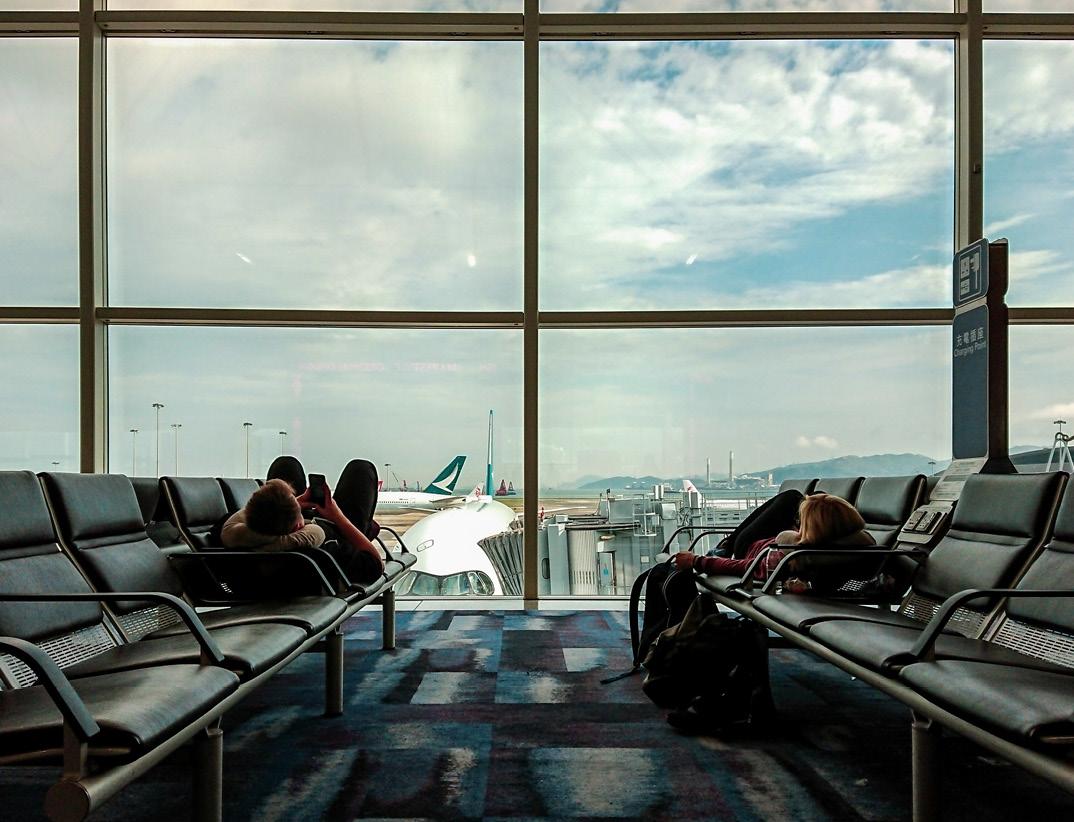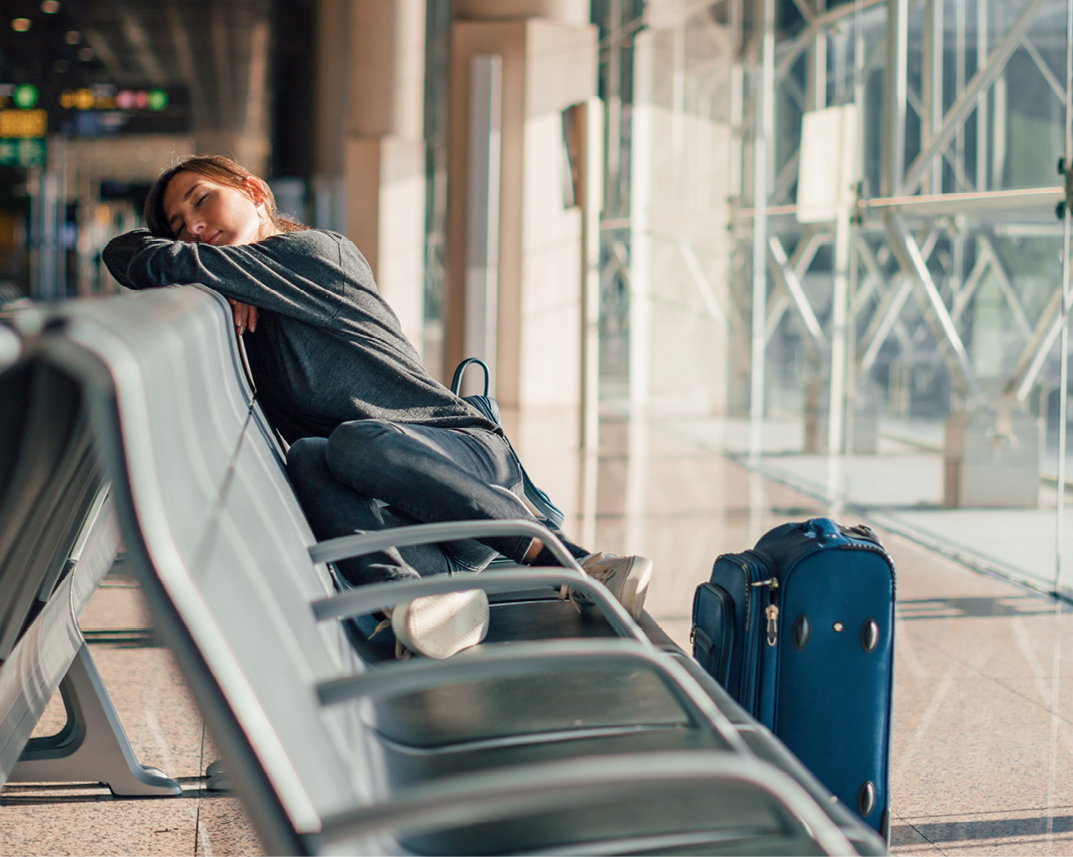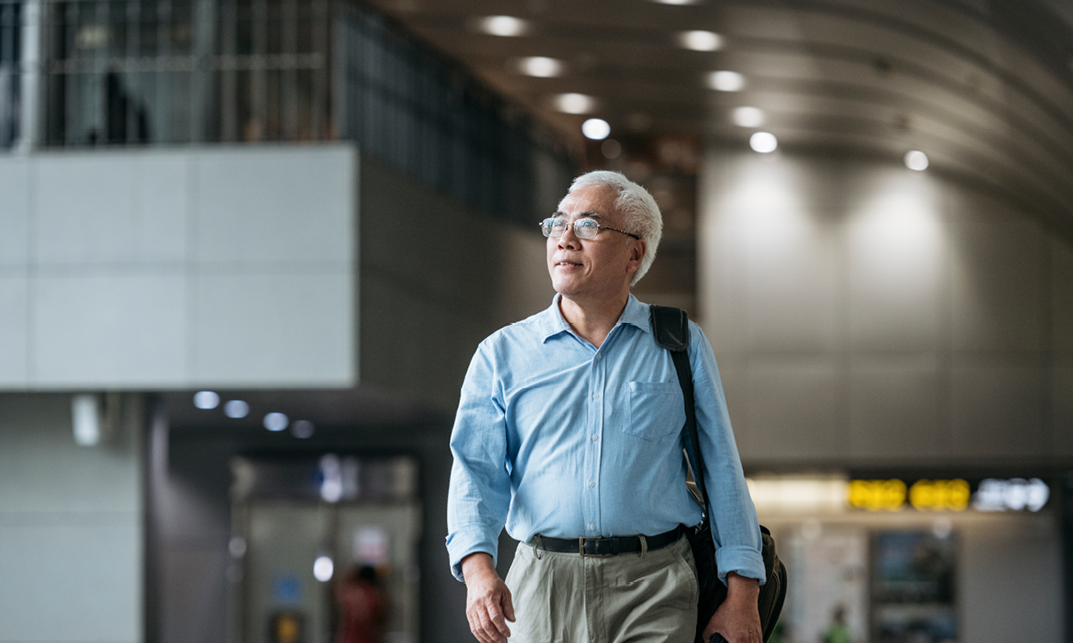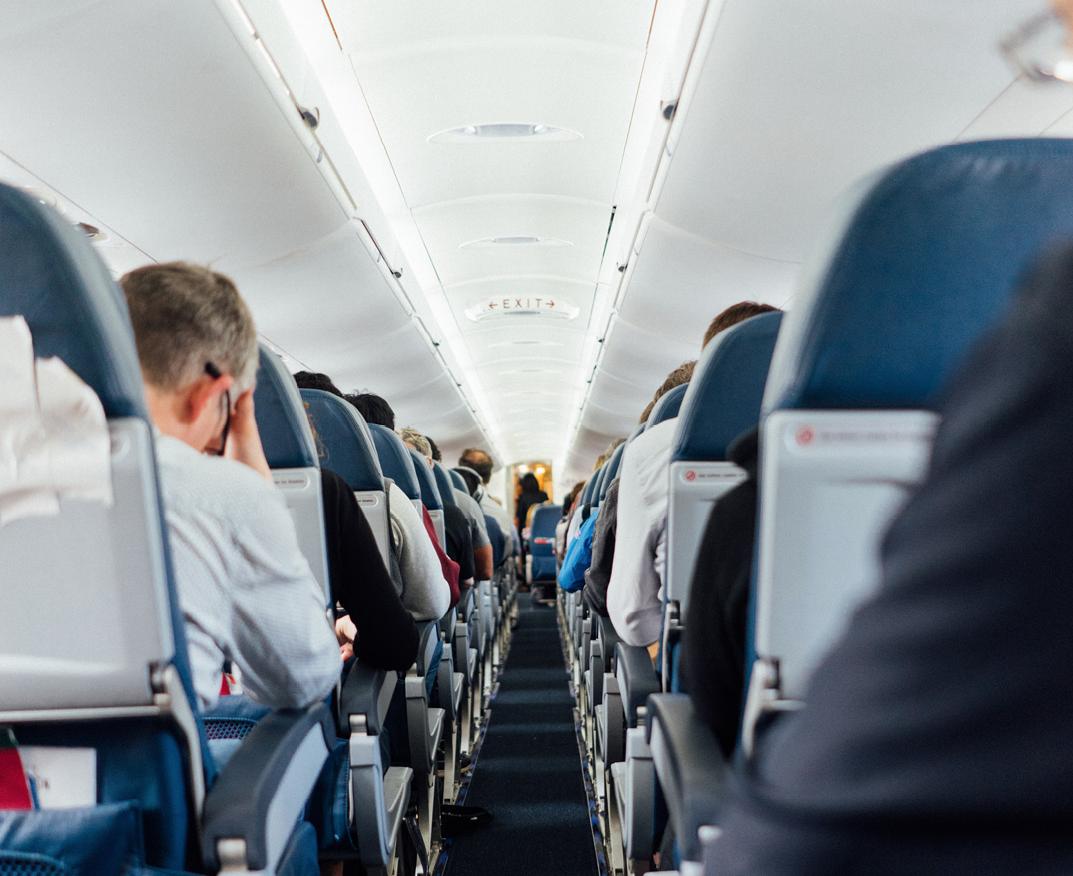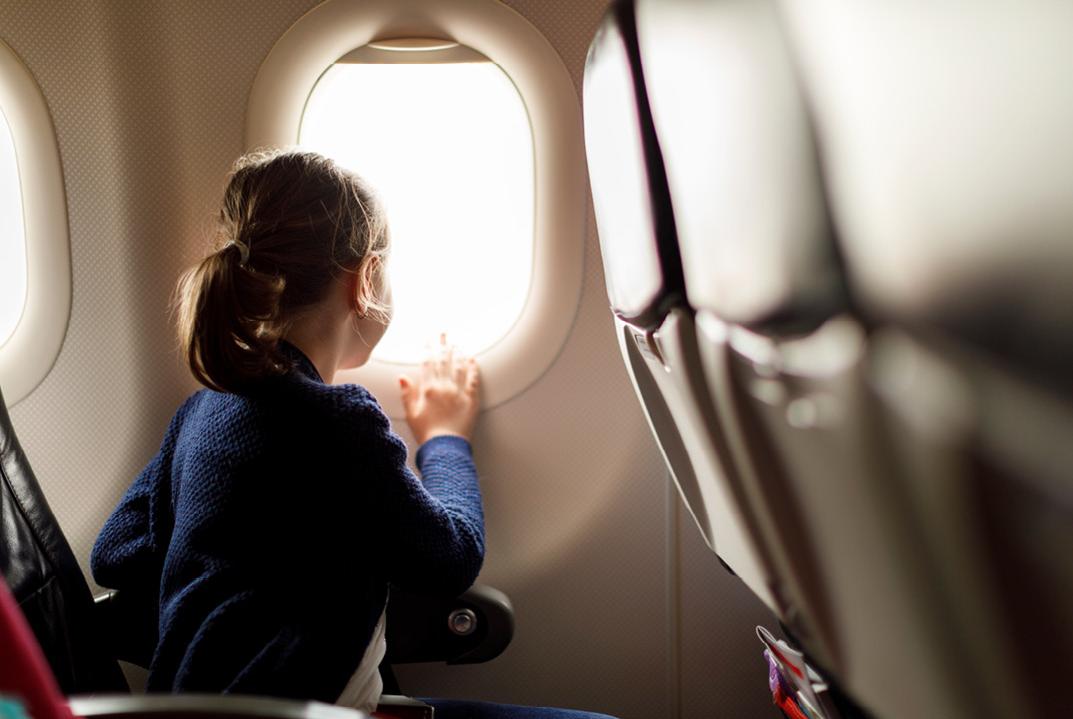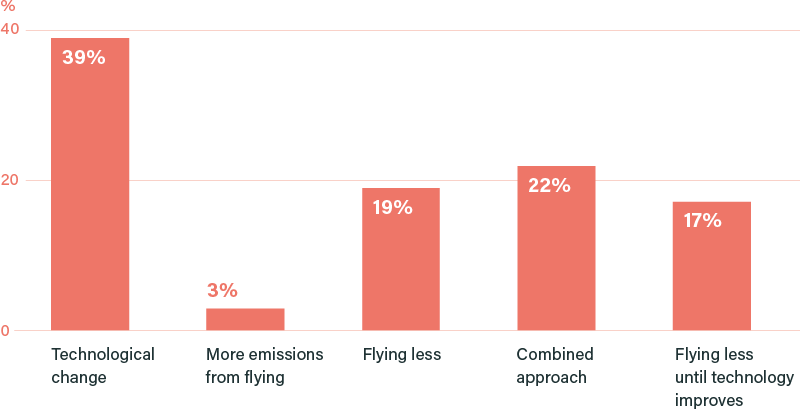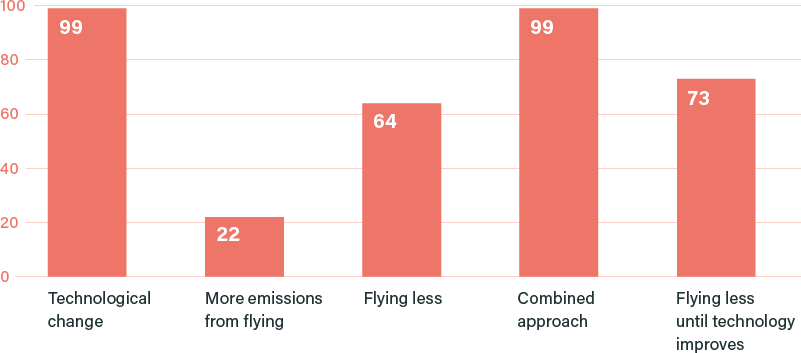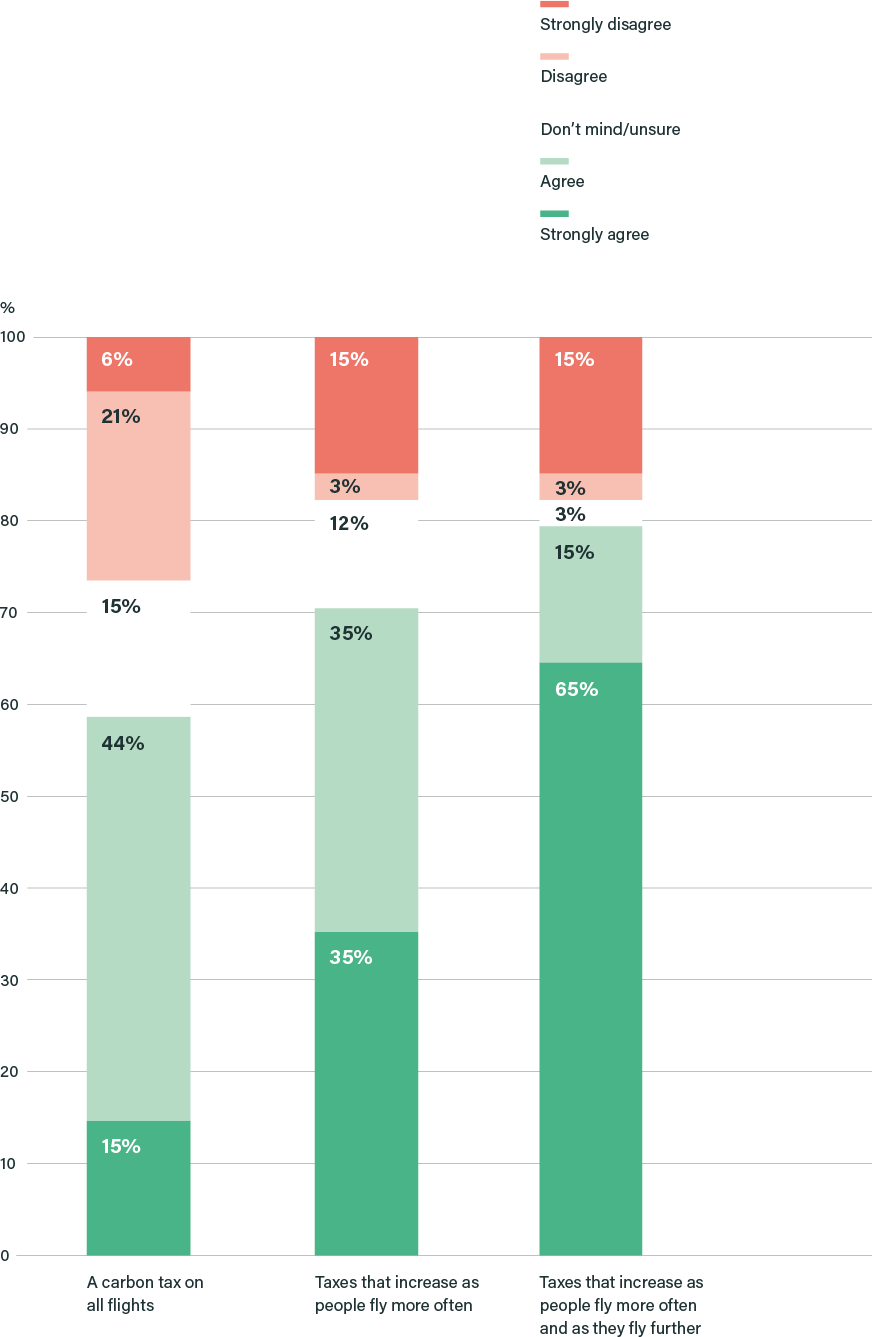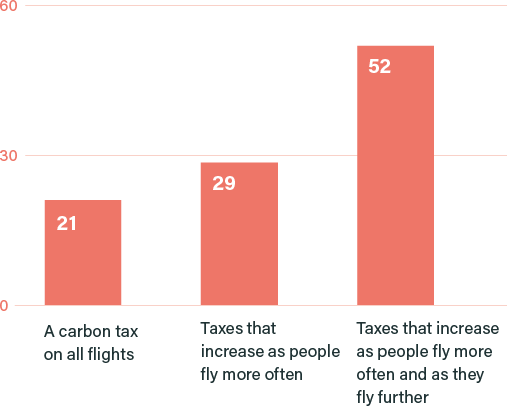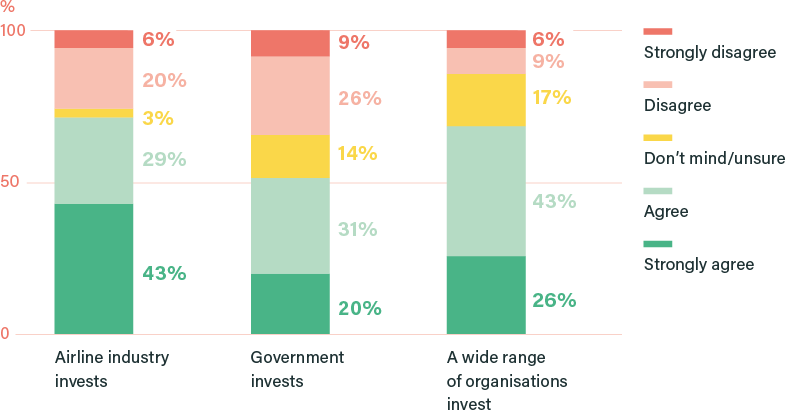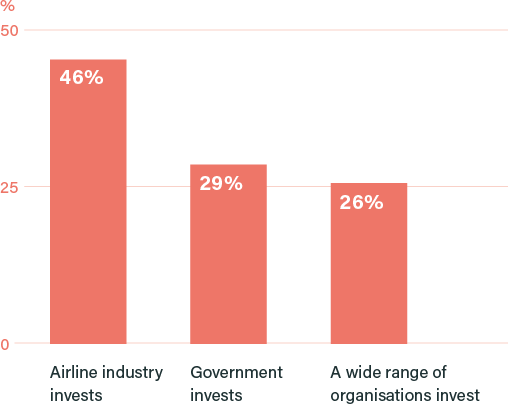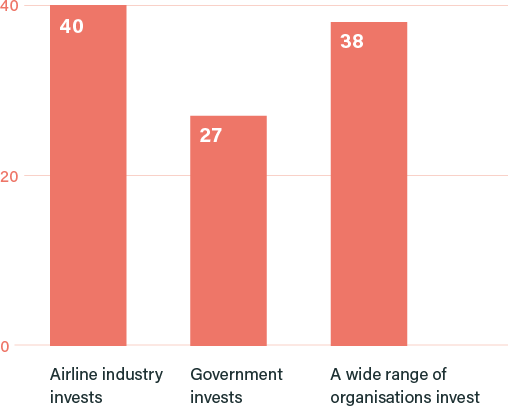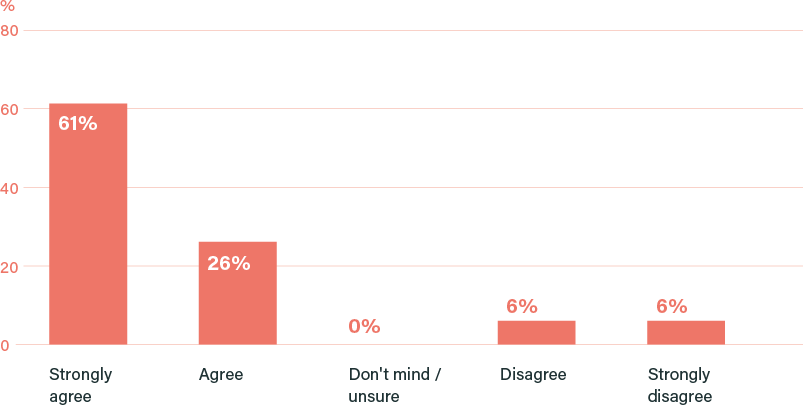How we travel by air
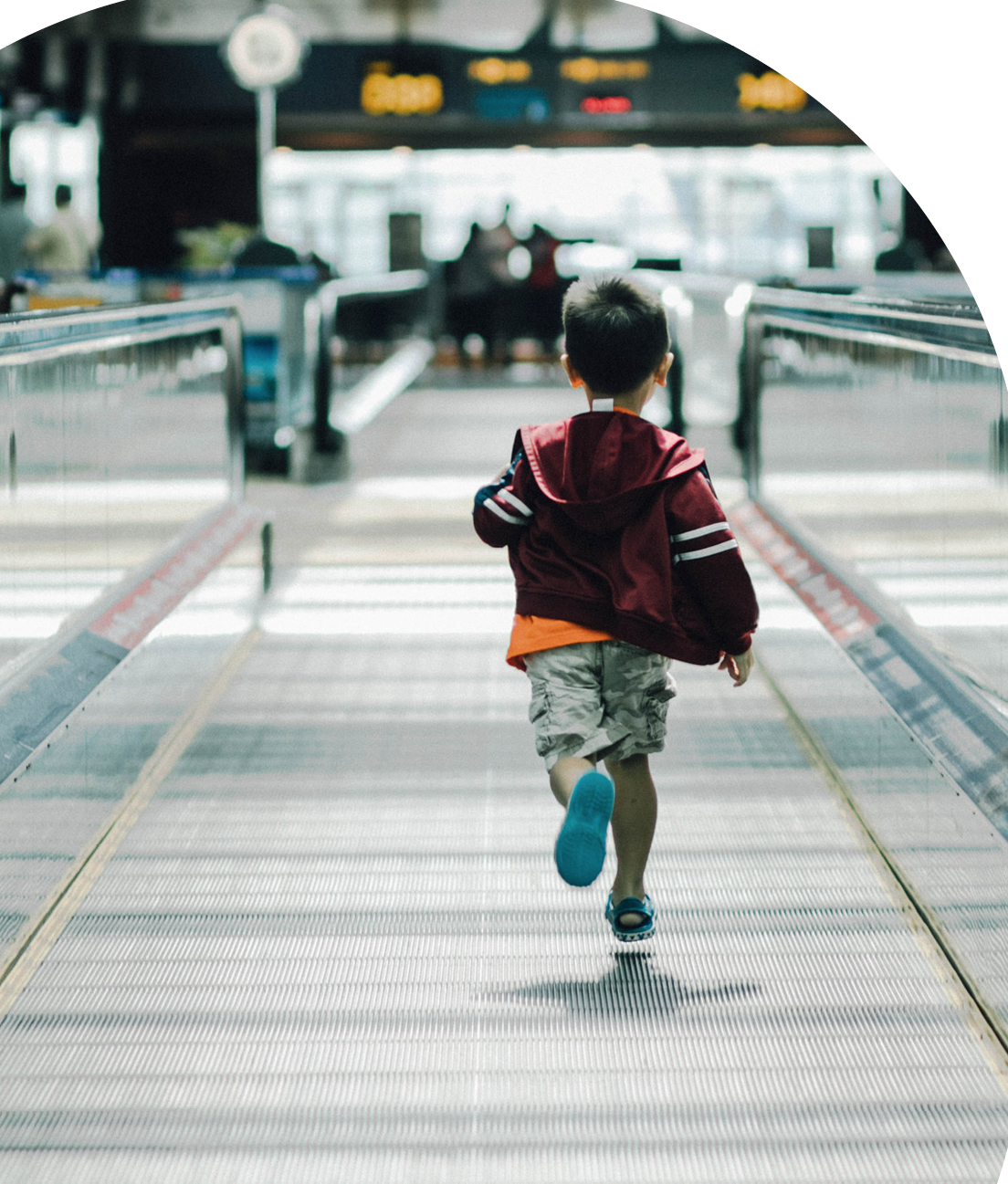
Previous section: How we travel on land
(Contents)
- Assembly members identified 14 considerations that they would like government and Parliament to bear in mind when looking at air travel and the path to net zero. These included speeding up progress on technology, influencing the rest of the world, and evening out the cost of air travel versus alternative forms of transport by making the latter cheaper and better.
- Assembly members would like to see a solution to air travel emissions that allows people to continue to fly. Assembly members felt that this would protect people's freedom and happiness, as well as having benefits for business and the economy. However their support for continued flying had limits. Assembly members resoundingly rejected a future in which air passenger numbers would rise by as much as 65% between 2018 and 2050, labelling it "counterproductive". Instead, assembly members sought to find an acceptable balance between achieving the net zero target, impacts on lifestyles, reliance on new technologies, and investment in alternatives. Their preferences point to a future in which:
- Air passenger numbers increase by 25–50% between 2018 and 2050, depending on how quickly technology progresses. This is a lower rate of growth per year than was seen in recent times1 prior to Covid-19;
- 30m tonnes of CO2 is still emitted by the aviation sector in 2050 and requires removing from the atmosphere;
- There is investment in alternatives to air travel.
- 80% of assembly members 'strongly agreed' or 'agreed' that taxes that increase as people fly more often and as they fly further should be part of how the UK gets to net zero. Assembly members saw these taxes as fairer than alternative policy options.
- Assembly members would like to see the airline industry invest in greenhouse gas removals. 75% of assembly members 'strongly agreed' or 'agreed' that this should be part of how the UK gets to net zero. There was also significant support for financial incentives from government to encourage a wide range of organisations to invest. Assembly members' tended to feel that 'the polluter should pay', although some suggested a need to monitor, scrutinise and perhaps enforce airline industry investment to ensure it actually takes place.
- 87% of assembly members strongly agreed that we need to invest in the development and use of new technologies for air travel. These technologies could include electric aircraft and synthetic fuels.
Notes ():
1: A 25–50% increase between 2018 and 2050 is equivalent to a growth in passenger numbers of between 0.7% and 1.3% per year. Between 2000 and 2018, the annual rate of growth in passenger numbers was 2.8%. Department for Transport (2019) Aviation Statistics: data table AVI0101: https://www.gov.uk/government/statistical-data-sets/aviation-statistics-data-tables-avi
Air travel accounts for 22% of the UK's total greenhouse gas emissions from transport, and 7% of the UK's total greenhouse gas emissions overall.2 Emissions from flying have grown significantly in the last 30 years.3
Notes ():
2: BEIS (2019) Final UK greenhouse gas emissions national statistics 1990–2017. These figures do not include military aircraft and shipping.
3: Department for Transport (2019), Energy and environment: data tables, https://www.gov.uk/government/statistical-data-sets/energy-and-environment-data-tables-env, Table ENV0201.
Air travel's contribution to UK emissions comes from both:
- Domestic travel – travel within the borders of the UK; and
- International travel – travel that starts in the UK but ends in another country. 96% of the UK's air travel emissions are from international flights.4
Notes ():
4: Department for Transport (2019), Energy and environment: data tables, https://www.gov.uk/government/statistical-data-sets/energy-and-environment-data-tables-env
Excluded from these figures are flights from other countries to the UK (for example, return flights from holidays), or travel that UK residents take within other countries or from one foreign country to another. Climate Assembly UK followed the same criteria when deciding what was, and was not, in scope for its discussions.
Air travel also includes both passenger or 'personal' transport, and freight. Personal transport is what people use to travel for pleasure, like going on holiday or visiting family and friends. It also covers travel for work. Freight is transport used to move goods. Climate Assembly UK considered personal transport only. It did not look at freight.5 This followed guidance from Parliament that, if there was not time to consider both, its committees most wanted to hear assembly members' views on personal transport.
Notes ():
5: Climate Assembly UK speaker Dr Sally Cairns calculated that freight account for 12–14% of emissions from aircraft.
Thirty-six assembly members considered the topic of air travel in-depth. We selected these assembly members from the assembly as a whole using random stratified sampling. This ensured that they remained reflective of the wider UK population in terms of both demographics6 and their level of concern about climate change.
Notes ():
6: Age, gender, ethnicity, educational qualification, where in the UK they live and whether they live in an urban or rural area.
These assembly members heard a wide range of views both on what the future of air travel could look like for the UK, and how we might move towards that future. They had the opportunity to question each speaker7 in detail. These evidence sessions took place at weekend two of the assembly.
Notes ():
7: The assembly heard from six speakers on air travel: Professor Jim Watson, University College London (informant); Owen Bellamy, Committee on Climate Change (informant); Professor Alice Larkin, University of Manchester (informant); Dr Sally Cairns, University of Leeds (informant); Leo Murray, Possible (advocate); Rachael Everard, Rolls Royce (advocate). All speakers' presentations are available as slides, videos and transcripts at climateassembly.uk/resources/. An 'informant' is a speaker who we asked to cover the range of views and available evidence on a topic. An 'advocate' is a speaker who we asked to give their own view, or the view of their organisation. Assembly members knew whether speakers were informants or advocates.
Assembly members spent weekend three of the assembly discussing the evidence they had heard and their own views, before reaching recommendations on three separate areas:
- Considerations: the overarching considerations that government and Parliament should bear in mind when making decisions about air travel and the path to net zero;
- Futures : what the future of air travel in the UK should look like;
- Policy options: how the UK should move toward this future.
Assembly members also had the opportunity to discuss and add anything else they wanted to say to government and Parliament about air travel and the path to net zero. Assembly members' views on the implications of Covid-19 for this topic are touched on in Chapter 10.
Assembly members reached their first decisions on air travel by discussing their answers to the following question:
What considerations should government and Parliament bear in mind when making decisions about air travel and the path to net zero?
Assembly members thought about their answers to this question individually. They then discussed their views in small groups at their tables, with each table agreeing their five top considerations. These top considerations had to, between them, represent the range of views at the table.
Facilitators took the top considerations from each table and grouped similar options together to create a list on which assembly members could vote. They checked this list back with assembly members to make sure they had accurately reflected their views. This included making any necessary adjustments. Each assembly member voted for the four options that they felt to be most important.
The results were as follows. The wording of the considerations in the table is either word for word what assembly members wrote on their option cards or, where facilitators combined similar options from several tables, how they described the options to assembly members prior to the vote.
| Rank | Consideration | % assembly members who chose it as a priority |
|---|---|---|
1 | Taken together, the following two considerations had the most votes:
| 53 25 28 |
=2 | Influence the rest of the world (USA and China) – e.g. tax on aviation fuel needs to be worldwide | 50 |
=2 | Even out the costs of air travel compared to alternatives by making alternatives cheaper and better, including increasing capacity to cater for increased demand | 50 |
4 | Frequent fliers and those that fly more distance should pay more | 44 |
=5 | Stay competitive and protect the economy, including addressing the impact on business and the travel industry | 31 |
=5 | Engage the population in making the necessary changes (education, promotion, explanation) | 31 |
7 | Take account of different travel needs (e.g. people with family far away, the military, people who live on islands, medical needs) | 25 |
=8 | Promote and incentivise UK holidays | 22 |
=8 | Scrap incentives to make people fly more (e.g. air miles, 1st class) | 22 |
10 | Ban polluting private jets and helicopters, moving to electric technology as it becomes available | 19 |
=11 | Ensure choices are accessible and affordable to all sections of society | 14 |
=11 | Don’t limit how much individuals travel | 14 |
13 | Even out the costs of air travel compared to alternatives by making air travel more expensive | 8 |
14 | Make those who take more expensive modes pay more (i.e. in carbon tax), including those who use private jets | 3 |
Note: It is worth noting that, taken together, the options about evening out the costs of air travel compared to alternatives would have the most votes. These options came joint second and thirteenth in the vote, respectively. However it is possible that some assembly members voted for both these options, which is why they are not combined in the table above. This is not the case for the options that came first, where assembly members agreed prior to the vote that they could only vote for one of them.
After deciding their most important considerations, assembly members moved on to look at the future of air travel for the UK.
To aid them in this process, the Expert Leads presented assembly members with five scenarios for possible futures:
- Technological change;
- More emissions from flying;
- Flying less;
- Combined approach;
- Flying less until technology improves.
Together these scenarios cover a broad range of views about how air travel could change to help the UK reach net zero.
Each scenario presented to assembly included a different combination of assumptions about:
- How much to reduce the amount we fly, by for example:
- Taking fewer holidays and business trips, including using video conferencing;
- Shifting shorter flights to other forms of transport such as high speed rail or ferries;
- How quickly we are able to make planes more efficient and develop new engine technologies, for example electric aircraft;
- How quickly we are able to shift from fossil fuels to biofuels and synthetic fuels;
- The quantity of greenhouse gas emissions remaining from air travel in 2050 that will need removing from the atmosphere to meet the net zero target.8
Notes ():
8: Even if technologies and policies to move towards net zero are successful, it is very likely that there will still be emissions from flying in 2050: emissions from flying have grown significantly in the last 30 years; new technologies and fuels that could substantially reduce emissions – such as synthetic fuels and electric aircraft – are at an early stage of development and their future impact on emissions is uncertain.
Assembly members discussed each of the scenarios or 'possible futures', before voting on them by secret ballot.
We start by presenting the rationale for their views, taking each possible future in turn.
This future would see increased air travel, with technology used to reduce emissions. It would feature:
- A 50% growth in air passenger numbers between 2018 and 2050;9
- A higher rate of technology progress than in some other scenarios, leading to improved fuel efficiency;
- A high use of low carbon fuels (25% of fuel by 2050);
- Some hybrid electric aircraft by 2050;
- Emissions in 2050 that are lower than today, amounting to approximately 30m tonnes of CO2 per year. These remaining 30m tonnes of CO2 would need to be removed from the atmosphere.
Notes ():
9: A 50% growth in passenger numbers between 2018 and 2050 is in line with the Department for Transport's central forecast, which assumes that airport capacity is not expanded. [source: https://assets.publishing.service.gov.uk/government/uploads/system/uploads/attachment_data/file/878705/uk-aviation-forecasts-2017.pdf]
Assembly members discussed this possible future in small groups. They identified the following pros and cons.
Pros
- Less restrictive on people's lives – some assembly members suggested that this future provided "an acceptable balance with lifestyles and carbon emissions" or "maximum gain for least pain."
- Focus on technology – some assembly members stated their support for "rapid technological improvements." Others suggested that a focus on technology is "good for the economy" or noted "we have the technology – use it…."
- "Significant shift away from fossil fuels"
Cons
- Concerns about rising passenger numbers – some assembly members suggested that a 50% rise was "large" or "too high." Others said the "best way to reduce CO2 is to reduce the amount we fly; this has a large increase."
- Uncertainty about technology and fuel improvements – some assembly members said technology and fuel improvements are "not quite ready" or that this future "contains assumptions" about when they will be ready, which might be "wishful thinking."
- "Doesn't help improve CO2 levels quick enough"
- "Relies on international agreement e.g. on fuel standards"
Assembly members made the following additional comments in relation to this possible future:
"We always have to put this in an international context."
"Every option will be impactful on current behaviour. People will have to get on with that."
"We have to set an example."
When we asked assembly members to rank the possible futures in their order of preference, this future received significant support from assembly members. Please see page 135 for the vote results.
This scenario would involve slower growth in air travel than has been the case in recent years, alongside the use of some new technologies and fuels. They noted that it would feature:
- A 25% growth in air passenger numbers between 2018 and 2050;
- Investment in high speed rail and alternatives to business travel;
- A higher rate of technology progress compared to some of the other futures, leading to improved fuel efficiency;
- Moderate use of low carbon fuels and hybrid electric aircraft;
- Emissions in 2050 that are lower than today, amounting to approximately 30m tonnes of CO2 per year. These remaining 30m tonnes of CO2 would need to be removed from the atmosphere.
Assembly members discussed this possible future at their tables. They identified the following pros and cons.
Pros
- "Allows an acceptable best of both worlds" – some assembly members felt this future "target[s] all aspects of the problem but allow[s] growth". Others noted that it would make "emissions lower," whilst being "not a drastic change in lifestyle."
- More achievable – some assembly members commented that "growth in air passengers cannot suddenly stop."
- Public appeal – some assembly members felt that this future is "likely to appeal to most people" or "can enable a ground swell of support."
- Investment in alternatives – for example, some assembly members voiced their support for high speed rail.
- "Use of technology as part of the solution"
Cons
- Unachievable – some assembly members commented that the "slower growth in air travel [is] not possible to achieve."
- Doubts about technology – some assembly members felt that "the technology is still uncertain and unproven."
- Amount of CO2 removal – some assembly members were concerned about the "very high requirement for CO2 removal."
- Lacks ambition – some assembly members felt this future was "just a slower version of 'fly less until technology improves'."
- "Too pessimistic"
One assembly member suggested that this scenario "requires a lot of education to make it work".
When we asked assembly members to rank the possible futures in their order of preference, this scenario received significant support from assembly members. Please see page 135 for the vote results.
Assembly members voted on the possible futures by secret ballot. The ballot paper asked them to rank the futures in their order of preference.
The votes were counted in two ways:
- Counting assembly members' first preference votes only. This tells us what assembly members would and wouldn't choose if they could have their preferred future.
- Using Borda count. This involves allocating points for preferences – a first preference vote scored four points, a second preference vote 3 points and so on. A fifth preference vote scored no points. Counting the votes like this tells us which futures are most acceptable to the greatest number of assembly members.
Technological change 39%
More emission from flying 3%
Flying less 19%
Combined approach 22%
Flying less until technology improves 17%
Figure 1: Possible futures: Please rank the possible futures in order of preference (% 1st preference votes)
'Technological change' received significantly more first preference votes than the other futures. 'More emissions from flying' received almost no votes. A majority of assembly members (58%) chose as their first preference a future that would see passenger numbers rise by just 15–25% by 2050 – a much lower figure than the 50% increase under 'technological change'.
Assembly members who chose 'technological change' as their first preference wrote a range of reasons for their choice on their ballot papers, including:
"I think it is most sensible to push for an advance in technology because other ideas seem to just be putting off or avoiding the problems, instead of trying to solve them."
"Has a reasonable level of CO2 emissions … which may be achievable to remove from the atmosphere."
"Freedom of movement is important to me."
"It seems the most realistic and practical solution – as we are an island people need to fly."
"Most socially acceptable option."
"It also still allows a high growth level which is important to the economy and businesses."
"I believe the answer to all the problems in relation to emissions (within aviation) lies in technology."
In the Borda count, 'technological change' and 'combined approach' received almost identical scores. 'More emissions from flying' again scored poorly.
Technological change 99
More emission from flying 22
Flying less 64
Combined approach 99
Flying less until technology improves 73
Figure 2: Possible futures: Please rank the possible futures in order of preference (Borda count)
Assembly member who chose 'combined approach' as their first preference gave a range of reasons for their choice. This included a feeling that this future is 'balanced', with some noting their support for investment in alternative forms of transport. Comments included:
"Combines passenger growth with investment into surface transports. And a reasonable amount (30 m tonnes) of CO2 to be removed."
"Emissions lower, alternatives to flying being invested in so not forcing people to completely stop travelling – not a very drastic change in lifestyle. Most realistic option as growth in air passengers cannot suddenly stop."
"Seems obvious to make best efforts on all fronts including some small behaviour change."
"Overall the investment in high speed rail. And higher rate of technology."
"Most achievable and likely to be acceptable to the majority."
Overall, assembly members' preferred futures were 'technological change' and the 'Combined approach', with the former securing substantially more first preference votes (39% to 22%).
Comments in group discussions and on their ballot papers suggest that assembly members' reasons for supporting 'Technological change' centred on a wish for a solution to air travel emissions that allows people to continue to fly. They cited rationale including freedom and happiness for this preference, as well as – to a slightly lesser extent – benefits to business and the economy. Some assembly members expressed scepticism about the feasibility of significant changes to passenger numbers.
Assembly members' support for continued flying did, however, have limits:
- The scenario that included the greatest increase in air passenger numbers ('more emissions from flying') secured just 3% of first preference votes and received least support by a considerable margin in the Borda count. Assembly members suggested that it would be "counterproductive", involved too great a reliance on greenhouse gas removals, and would have knock-on effects in terms of requiring greater change in other areas of people's lives;
- While 'technological change' was clearly the most popular scenario in terms of first preference votes, a majority of assembly members (58%) chose as their first preference a future that would see passenger numbers rise by just 15–25% by 2050 – a much lower figure than the 50% increase included under 'technological change'. Some assembly members expressed uncertainty about when fuel and technological improvements would be ready. Others highlighted the benefits of flying less, for example for reducing emissions.
This split in first preference votes makes the Borda count results particularly instructive. They suggest that the two scenarios that large numbers of assembly members could live with, even if they were not their first preference, are 'technological change' and the 'Combined approach.' For some assembly members the latter offered "an acceptable best of both worlds" that was likely to be more achievable and acceptable to the public, and which included investment in alternative forms of transport. Taken together, these two scenarios suggest a future in which:
- Air passenger numbers increase by 25–50% between 2018 and 2050, depending on how quickly technology progresses;
- 30m tonnes of CO2 is still emitted by the aviation sector in 2050 and requires removing from the atmosphere.
During the discussions, some assembly members asked for an additional option to be added to the ballot paper:"Taxes that increase as people fly more often and as they fly further." The Expert Leads accepted this request.
Assembly members looked at two options for managing the amount we fly:13
Notes ():
13: Other policies that could have been included here – for example no further airport expansion or investment in alternatives to flying – were embedded in some of the possible futures covered in Section B. Support for the development and use of new technology was also covered separately in a later vote (please see page 153). These options therefore focus on taxation.
- A carbon tax on all flights;
- Taxes that increase as people fly more often.
During the discussions, some assembly members asked for an additional option to be added to the ballot paper:
- Taxes that increase as people fly more often and as they fly further.
We accepted this request.14
Notes ():
14: Assembly members did not discuss this option in-depth because it was added so close in to the vote. We are therefore unable to include a full rationale for assembly members' views about it. However, their comments on the other two policy options, shed considerable light on why assembly members wanted it included.
This section starts by presenting the rationale for assembly members' views, taking each policy option in turn.
A carbon tax on all flights
This would involve replacing the current tax on flights15 with a carbon tax based on the amount of CO2 emitted for each passenger. The carbon tax paid could be varied by cabin class, although it would not have to be. For example, business class passengers could be asked to pay a higher amount.
Notes ():
15: The current tax is called Air Passenger Duty. It does not reflect the impact of air travel on climate change because the rates of tax do not reflect the emissions produced.
Assembly members identified a number of pros, cons and conditions about a carbon tax on all flights. Conditions are measures that some assembly members said would need to be in place for them to support this policy option.
Pros
- Direct relationship to carbon emissions – some assembly members liked that it "reflects carbon emission on specific travel" or "directly relate[s] to CO2 emissions."
- Fairer – some assembly members suggested it is "a fairer way to tax users and airlines." Others liked that "you would be taxed at use."
- The right thing to do – some assembly members commented that "it is right people should pay more" or said "we need to reduce emissions. We need to reduce flying."
- Simple – some assembly members felt this option was "simple to administer" or would be the "easiest to implement and manage."
- Vary tax by cabin class – some assembly members supported the idea of "vary[ing] tax by cabin class."
- Encouraging efficiency – some assembly members said "it may encourage efficiency if they [flights] become more expensive."
Cons
- Impact on people with lower incomes – several assembly member expressed concerns that the "significant increase in flight cost" would have a "disproportionate effect on [people with] lower incomes." Similar comments included:
"Will low incomes be able to afford their one holiday a year?"
"Price out lower incomes"
"Cost of flying could increase to the point only the wealthy can fly."
Others labelled it a "non progressive tax" or said it "discriminates more against poor people." Some assembly members felt the "rich will still be able to pay" or asked "what level of disincentive [is needed] before [the] richest stop flying?"
- Unfair and too blunt – some assembly members disliked that it "will make everyone's flights more expensive" or "put the cost of flying up for everyone", with some suggesting this was "not fair." Others noted that "15% of people take 70% of flights." Others branded it "too blunt an instrument" with "disproportionate effects."
- Increase in cost to passengers – some assembly members suggested that "it significantly increases the cost of flying" or is a "high tax." Others predicted that the "cost [would be] passed on to [the] passenger" or said they were "afraid [we would] end up with air passenger tax plus carbon tax."
- Restricting – some assembly members said it would "restric[t] choice" or that there would be "less flights."
- Lead to slower improvement in technology – some assembly members suggested it would lead to "less in revenues and therefore investment in technologies" or said that a "tax on fuel will drive more efficiency."
- Education – some assembly members said reduced flying would mean "not learning about different cultures." Others said that "education will suffer."
- Avoidance – some assembly members felt it would be "difficult or impossible to prevent avoidance", with some suggesting overseas connections could be used in that way.
- "Increasing taxes will discourage world trade for UK PLC"
- "It will affect me negatively"
- "Low cost airlines may make UK less efficient planes"
Conditions
- Where the money goes – some assembly members said they would support a carbon tax if revenues were "ringfenced", "ringfenced for technology development" or "dependent on where money goes – i.e. investment in new technology fuels etc." Others asked "can we make government invest in technologies and not anything else (ringfence)?"
- Transparency and trust – some assembly members said it would be "okay if there is transparency" or that we would "need a trustworthy way of calculating carbon per flight."
- Being more targeted – some assembly members suggested that you "would need to consider exemptions for special cases", or that "there is a distinction to be made between family and business." Others asked "what are the tax implications for children flying?"
In the voting, a carbon tax on all flights received some support from assembly members. Please see below for the results of the vote.
Taxes that increase as people fly more often
This would involve replacing air passenger duty with a tax that increases as people fly more often. This could be done so that people who only fly once in a year pay no tax. The tax paid could also be varied by cabin class although it would not have to be. For example, business class passengers could be asked to pay a higher amount.
Assembly members identified a number of pros, cons and conditions about taxes that increase as people fly more often.
Pros
- Fairer – several assembly members commented on "fairness". For example:
"Penalise people who travel a lot – fairer to those who don't."
"Targets the 15% who take 70% of the flights."
"It is fairer. Those who pollute more, pay more of it. Doesn't disproportionately affect low income people."
"I really like this option. I think it's fair."
"Seems fair for people who have less."
"Fairer to passengers."
"Like the escalator aspect."
- "Could potentially persuade people not to take less needed flights or find alternatives (e.g. train)"
- "Vary tax by cabin class"
- "Likely to be more acceptable to more people"
Cons
- Doesn't reflect distance flown – some assembly members disliked that it "doesn't take into account distance" or suggested that "this wouldn't be fair if one person's long-haul flight for the year is free – but if someone takes 3 short haul flights they have to pay." Others asked "what if your first flight of the year is short haul, and the second is long haul – is the charge reflective in any way?"
- Too blunt – some assembly members felt it would be "disproportionate to certain groups (families)" or would "penalise family relationships." Others asked " would there be exemptions for essential flyers – e.g. surgeons?" or suggested that it "needs safeguards and conditions built in."
- "People travelling a lot will be from a higher income background, so will continue to fly regardless"
- "Variable rate of tax applied makes prices uncertain"
- "Increases cost of flying for some people"
- "Reduces incentive for airlines to decrease CO2 "
Conditions
- Where the money goes – some assembly members said their support would be "dependent on where money goes – i.e. investment in new technology, fuels etc" or that they would support it "if [the income was] ringfenced."
- Exemptions for certain groups – picking up one of the points from the 'cons' list, some said policy-makers "would need to consider exemptions for special cases" or asked "what are the tax implications for children flying?"
- "Companies will have to pay the levy for their workers' business flights"
- One assembly member said they would support this option if the number of miles someone flew was also taken into consideration
In the voting, taxes that increase as people fly more often received significant support from assembly members. However they did not receive as much support as taxes that increase as people fly more often and as they fly further. Please see page 143 for the vote results.
Additional ideas
Assembly members raised a number of additional ideas for policy options in this area:
"We could have both (with a smaller fairer carbon tax and higher frequent flyer levy)"
"Escalating carbon tax depending on how often you fly"
"Tax on fuel will drive more efficiency"
One assembly member commented "we are having to vote on tax – are there other options?! Tax by back door."16
Notes ():
16: Please see footnote 14 on page 138.
Vote results
Assembly members voted by secret ballot on policy options for managing the amount we fly. There were two ballot papers. The first ballot paper asked assembly members how much they agreed or disagreed that each policy option should be part of how the UK gets to net zero. The second ballot paper asked them to rank the options in their order of preference. The votes from this second ballot paper were counted both in terms of first preference votes and via Borda count.
A majority of assembly members 'agreed' or 'strongly agreed' that all the policy options should be part of how the UK gets to net zero. However some policy options were clearly much more supported than others.
The most popular option was 'taxes that increase as people fly more often and as they fly further.' 81% of assembly members 'agreed' or 'strongly agreed' that this should be part of how the UK gets to net zero, with an outright majority of 65% strong agreeing. This was followed by "taxes that increase as people fly more often (70% 'agreed' or 'strongly agreed'), with a carbon tax on all flights (59%) bringing up the rear.
A carbon tax on all flights also received much lower levels of strong support than the other options – 15%, compared to 35% and 65% respectively.
The results of the preference votes paint a similar picture. 'Taxes that increase as people fly more often and as they fly further' was by some distance the most popular option in terms of both first preference votes and the Borda count. A carbon tax on all flights remained the least popular option, again by some margin.
A carbon tax on all fights
15% Strongly Agree
44% Agree
15% Don’t mind or unsure
21% Disagree
6% Strongly disagree
Taxes that increase as people fly more often
35% Strongly Agree
35% Agree
12% Don’t mind or unsure
3% Disagree
15% Strongly disagree
Taxes that increase as people fly more often and as they fly further
65% Strongly Agree
15% Agree
3% Don’t mind or unsure
3% Disagree
15% Strongly disagree
Figure 3: Managing the amount we fly: How much do you agree or disagree that each of the following policy options should be part of how the UK gets to net zero? (%)
A carbon tax on all fights 12%
Taxes that increase as people fly more often 21%
Taxes that increase as people fly more often and as they fly further 68%
Figure 4: Managing the amount we fly: Please rank the following policy options in order of preference (% 1st preference votes)
A carbon tax on all fights 21%
Taxes that increase as people fly more often 29%
Taxes that increase as people fly more often and as they fly further 52%
Figure 5: Managing the amount we fly: Please rank the following policy options in order of preference (Borda count)
Assembly members looked at three options for ensuring investment in greenhouse gas removals:
- Airline industry invests;
- Government invests;
- A wide range of organisations invest.
We start by presenting the rationale for their views, taking each policy option in turn.
This policy option would give the airline industry responsibility for investing in greenhouse gas removal measures to balance out remaining emissions from air travel.
Assembly members identified a number of pros, cons and conditions relating to this policy option.
Pros
- The polluter pays – some assembly members felt that the "industry that causes the problem should fix it". Comments included:
"The people causing the problem are responsible for the solution."
"Makes industry responsible for its own carbon."
"Since they are the ones contributing, they should have the responsibility to consider the removals or at least consider putting [in] less in the first place."
"Airline industry must take responsibility to capture their pollution and emissions. They must pay the true cost."
- Incentivising technological change – some assembly members suggested it would provide an "incentive to make improvements quickly", would "incentivise the industry to change" or would "encourage innovation by the industry." Others felt it "would prompt airlines to invest in new technology and cleaner planes."
- Targeted – some assembly members suggested it would have "no impact on people that don't fly" or that it would "not [be] costing [the] general taxpayer."
- "They will add to tickets which will change behaviour"
- "Possible to do by passing legislation"
- "Leave everything else to free market" (note: one assembly member countered this by suggesting "it isn't a free market; routes are set by government")
Cons
- Whether it would work – a significant number of assembly members expressed scepticism about whether it would work. Some simply queried "not possible?" Others talked about:
- Trustworthiness and monitoring – for example, some assembly members suggested there would be "high pressure on [the] airline industry to overstate/overestimate effectiveness of carbon capture – would result in untrustworthy figures." Others said "monitoring and enforcement would be needed" or asked: "How would this be implemented? How can we monitor what they do?" or "How will the money be spent or regulated to ensure they do?"
- Willingness – some assembly members suggested that "airlines may refuse [to invest] and move business outside the UK." Others said that it "seem[s] …an impossible task to persuade worldwide organisations – turkey voting for Christmas."
- Practicalities – some assembly members felt that the "'airline industry' is too diverse to do connected up research."
- Need for international agreement – some assembly members noted that "it's an international industry" or said "there will have to be agreements with more places abroad because of international flights." Some asked "what will happen if we don't get agreement with other countries."
- Not joined-up – some assembly members disliked that it is a "non-integrated approach" that doesn't include "other sectors" beyond air travel. Similar others commented: "Doesn't take other carbon emissions into account (not other sectors)."
Conditions
- "Investment in greenhouse gas removals"
- "Needs scrutiny by a third party to ensure removal is done right"
- "Matching investments need to be monitored – public money must not make private profit"
- "Must be only the funding generated by receipts from 1a [carbon tax on all flights] or 1b [taxes that increase as people fly more often]."
In the voting, this option received significant support from assembly members. Please see below for the results of the vote.
Government invests
This policy option would involve the government investing in greenhouse gas removal measures to balance out remaining emissions and ensure the net zero target is met. This would include emissions not just from air travel but also from other sectors likely to have remaining emissions in 2050, such as farming.
Assembly members identified a number of pros, cons and conditions about this policy option.
Pros
- Effective – some assembly members suggested it is a "good way to get it sorted" or that we are "hopefully more likely to reach net zero if [it's] under government investment."
- Positive about where the investment would go – some assembly members said the "Government should fund: universities, research industries and manufacturers to do research" or "invest in training in GHG [greenhouse gas] technology."
- "Demonstrates commitment of government to reduce greenhouse emissions"
- "You can see directly who you are holding responsible / accountable"
- "Match funding for business investment (to x%)"
- "Needs properly validated / audited carbon capture effectiveness measures. Think that only government has the credibility to produce accurate validated figures"
- "Government can introduce measures across all sectors"
Cons
- Unfair on people who don't fly – some assembly members said that "people who don't fly may object to government money being spent on the effects of the air industry." There were also several comments suggesting that "general taxation [is] not fair on those who don't fly."
- Could / would government do it – some assembly members suggested that it was "too expensive for the government to manage on its own" or that "changes in governments may affect decisions taken." Others felt that "big business [is] behind this. Biggest funders of [the] current government have [a] vested interest in this." Some felt it is "beyond the wit of government."
- Lack of effort from business – some assembly members disliked that there is "no onus on airline companies", or that we would be "subsiding an industry behaving badly."
- "Non-entrepreneurial"
- "Not in favour of tax onus"
- "Unclear where funding comes from"
- "Knock on effect on other areas in need of investment"
Conditions
- "The government have a responsibility but the taxation must not hurt the least well off"
- "Government should support and invest in organisations' and researchers' contribution but responsibility should not fall completely on them because it would not teach the individuals of their effects"
- "Government / Parliament can find [a] combination of ways to fund – worldwide approach / unfound so far"
In the voting, government investment received less support than the other policy options.
A wide range of organisations invest
This policy option would involve the government overseeing financial incentives to organisations that invest in greenhouse gas removal measures. This would include emissions not just from air travel but also from other sectors likely to have remaining emissions in 2050, such as farming. It could potentially involve a wide range of organisations receiving incentives.
Assembly members identified a number of pros, cons and conditions about this policy option.
Pros
- It would work – some assembly members felt it "would be enforced as overseen by government. Confident it would happen." Others suggested there is a "history of financial incentives working" or that there would be "pressure from many directions [so it's more] more likely to succeed."
- Advantages of working together – some assembly said the "economy as a whole will find ways if [we] work together" or that we "may have [a] better ability to meet the various challenges" if we take this approach. Others felt it would "maximis[e] investment and research into greenhouse gas removal across disciplines and ideologies" and that "encourage[ing] [this] investment could make [the] UK [a] world leader."
- "Shared responsibility amongst all who have an impact e.g. international businesses"
- "Cost of greenhouse gas removal shared more widely via general tax"
- "Frees up tax payer money for other services"
Cons
- Too generous to companies – some assembly members felt there would be "no onus on airline companies" or that it "does not place responsibility on the industry or people that cause remaining emissions." Others commented that it "seems like the usual big businesses will profit but seen or sold as a 'green movement'." In a similar vein, some assembly members suggested that the "companies behind this have already spoken to government and felt it would be better for government to introduce it as it's a £26 billion industry that will be subsidised??"
- Too many cooks – some assembly members worried that it "doesn't enforce a clear direction i.e. too many cooks" or that "n[o] one organisation has responsibility."
- "No rule/regulations to make change"
- "The use of general taxation in respect of air flight emissions is unfair to those who do not fly"
Conditions
- "Financial incentives are good for organisations to capture carbon, but only if they are non-profits or class b corporations"
- "Incentivised and driven by results e.g. Rolls Royce"
- "Each industry and organisation should pay to capture any emissions they produce"
In the voting, this option received significant support from assembly members.
Vote results
Assembly members voted by secret ballot on policy options for ensuring investment in greenhouse gas removals. There were two ballot papers. The first ballot paper asked assembly members how much they agreed or disagreed that each policy option should be part of how the UK gets to net zero. The second ballot paper asked them to rank the options in their order of preference. The votes from this second ballot paper were counted both in terms of first preference votes and via Borda count.
Airline industry invests
43% Strongly Agree
29% Agree
3% Don’t mind or unsure
20% Disagree
6% Strongly disagree
Government invests
20% Strongly Agree
31% Agree
14% Don’t mind or unsure
26% Disagree
9% Strongly disagree
A wide range of organisations invest
26% Strongly Agree
43% Agree
17% Don’t mind or unsure
9% Disagree
6% Strongly disagree
Figure 6: Ensuring investment in greenhouse gas removals: How much do you agree or disagree that each of the following policy options should be part of how the UK gets to net zero?(%)
A majority of assembly members 'agreed' or 'strongly agreed' that all the policy options should be part of how the UK gets to net zero. However some policy options received significantly more support than others.
The two most popular options were airline industry investment and investment from a wide range of organisations:
- 72% of assembly members 'agreed' or 'strongly agreed' that airline industry investment should be part of how the UK gets to net zero, with 43% 'strongly agreeing';
- A similar figure of 69% of assembly members 'agreed' or 'strongly agreed' that investment from a wide range of organisations should be part of how the UK gets to net zero, but significantly fewer (26%) 'strongly agreed'.
Investment from the airline industry was, however, also more controversial. 26% of assembly members 'disagreed' or 'strongly disagreed' that it should be part of how the UK gets to net zero, with just 3% saying they were 'unsure' or 'didn't mind'. The equivalent figures for investment from a wide range of organisations were 15% and 17%.
Government investment was the least popular of the three options, although a small majority (51%) still supported it. It was also more controversial than the other options with 35% of assembly members 'disagreeing' or 'strongly disagreeing' that it should be part of how the UK gets to net zero. 14% said they 'didn't mind' or were 'unsure'.
The results of the preference votes shed additional light on assembly members' views. First preference votes showed a strong lean towards airline industry investment, with government investment coming second and investment from a wide range of organisations third. The Borda count showed a slight lead for airline industry investment with investment from a wide range of organisations coming a very close second, and government investment third.
Figure 7: Ensuring investment in greenhouse gas removals: Please rank the following policy options in order of preference (% 1st preference votes)
Figure 8: Please rank the following policy options in order of preference (Borda count)
The potential of new technologies was a strong theme in assembly members' discussions throughout weekend three. At the beginning of the weekend, ideas in this area topped assembly members' list of considerations for government and Parliament to bear in mind (see Section A). 'Technological change' was also assembly members' preferred future (see Section B).
Towards the end of the weekend, some assembly members asked if there could be a further vote looking at whether investment in the development and use of new technologies for air travel should be part of how the UK gets to net zero. Assembly members discussed the suggestion at their tables before the vote took place.
Assembly members identified a number of pros, cons and conditions about investment in the development and use of new technologies.
Pros
- "Helps with advancing technology" – several assembly members suggested that "investment speeds up its [technology's] availability", or that "research always throws out new insights and solutions." Others felt it would "encourage multinational companies to collaborate" or result in "healthy competition to improve efficient new fuels." Some said that it would be a "shot in the arm for [the] UK research industry" or that they wanted "Government to 'sell' and 'encourage' [the] scientific community to get going."
- Business potential – some assembly members said that "technology can be sold to other countries" or that "Britain has strength in this area."
- Do it early – some assembly members said it was "critical" to do it "early", with some advocating "money and funding and front load it." Others noted a "need to do [it] soon due to [the] long lead time…."
- Impact on emissions – some assembly members felt it "will mean quicker CO2 reduction" and "could make differences to meeting [the] target of net zero."
- Preference for technology as a solution – some assembly members noted that it "could resolve the issue if a solution is found" or that "a solution means no guilt to travel." Others said technological solutions would involve "least waste", be "least disruptive" or have "less impact on people's lives." Some labelled it the "most progressive" or "most entrepreneurial" way forward.
- Support for synthetic fuels – some assembly members noted support specifically for investment in the development and use of technologies relating to synthetic fuels. Comments included:
"Carbon capture could be used for fuel rather than buried: as safety issues with burying have not been investigated."
"Storage is not entirely safe so might as well use it."
"Synthetic fuel could be used for land transport as well."
- "Prefer the developments towards more efficient air travel than methods of removing emissions after (e.g. carbon capture)"
- "Aviation seems like one of the most problematic areas for net zero currently"
- "If it doesn't affect your lifestyle maybe you will be inclined to help achieve it"
Cons
- Don't (just) do this – some assembly members said we "shouldn't rely on it, need to do other things as well e.g. reduce travel." Others urged "don't drop everything – i.e. not all eggs in [the] synthetic fuel basket", or said "not at [the] expense of, or to replace, other options." Some assembly members expressed stronger views, suggesting that "chasing a magic unicorn is not a solution. We don't know if it will be possible by 2050."
- Concern about where money comes from – some assembly members asked "where is the funding coming from?" or noted "concern – will cost money to government?"
- Not a good use of money – some assembly members said that "synthetic fuels are very expensive – reducing flights is a much cheaper way to reduce emissions." Others noted that it "could be just extra expense if not successful" or that it "could end up a big waste of time and money." Some assembly members felt that "public funds must not be used to generate private profits."
- "Limited funding pot and research resources"
- "Biofuels put more pressure on land use"
- "There may be safety / issues we are not aware of yet"
Conditions
- What type of technology is invested in – some assembly members said they would support it "if it is fuel produced" or if "synthetic fuels are considered differently from biofuels – as they take less space."
- Regulation or enforcement – some assembly members said "as long as usage of new fuels / technologies is enforced this must be part of the path to net zero" or said they support "invest[ment] in [the] development and use of technology for air travel – electric, hybrid, biofuels, synthetic fuel. Including regulat[tion of] airlines or producers to incentivise investment."
- "If this involves a significant increase in investment in this area"
- "Will it be better to capture carbon and use [it, rather] than store [it] underground?"
The ballot paper asked assembly members how much they agreed or disagreed that investment in the development and use of new technologies should be part of how the UK gets to net zero.
Their results show overwhelming agreement. 87% of assembly members 'agreed' or 'strongly agreed' with the statement, with a large majority (61%) strongly agreeing.
Figure 9: Investment in the development and use of technologies: How much do you agree or disagree that investment in the development and use of new technologies for air travel should be part of how the UK gets to net zero?(%)
At the end of weekend three, assembly members had the opportunity to add any further thoughts on air travel and the path to net zero. A small number of assembly members chose to add additional points. These centred around eight main areas:
- Need for action – some assembly members said we need to "make this a priority … it emits so much carbon!", "move away from 'business as usual'" or "think about future generations." Others suggested that we need to "stop making flying seem like a good thing / so attractive;"
- Specific types of flights and air-miles schemes – some assembly members made comments about specific categories of flights, suggesting that we "ban all non-essential air freight", "ban first class and business class seats" or "limit transit flights [as this] would help get to net zero more quickly." Some said that we "should get rid of air-miles schemes;"
- Alternatives to domestic flights – some assembly members emphasised that alternatives to local and domestic flights, such as rail travel, should be improved;
- Carrots and sticks for airlines – some assembly members said that "airlines should be taxed" or noted "airlines are being subsidised to create emissions; it is unfair;"
- Freight – some assembly members expressed disappointment that they had not been able to look at freight as well as personal transport use;
- International co-operation – some assembly members were keen to stress the international dimension to air travel and the path to net zero, commenting for example that "air travel is so international and global…. There needs to be international collaboration to bring about technological change;"
- Questions and concerns around a carbon tax – some assembly members commented:
"Are you going to take into account aircraft engines and occupancy in relation to emissions, which will affect the amount of carbon tax for each journey?"
"Carbon tax extreme example: You get on a plane, and find that you're the only passenger!"
- Airport expansion – one assembly member said the UK should "stop all airport and runway expansions. We can't expand while we aim to reduce emissions."
Assembly members expressed clear and consistent recommendations about air travel and the path to net zero.
There was strong support for steps to ensure that new technologies for air travel progress as quickly as possible. Assembly members chose "speeding up technology" as the top consideration they would like government and Parliament to bear in mind. They also expressed very strong support for investment in the development and use of new technologies for air travel. 87% of assembly members 'strongly agreed' or 'agreed' that this should be part of how the UK gets to net zero.
A key reason behind this preference is that many assembly members would like to see a solution to air travel emissions that allows people to continue to fly. Their rationale included a wish to protect people's freedom and happiness, as well as benefits for business and the economy. Their support for continued flying did however have limits. Assembly members resoundingly rejected a future in which air passenger numbers would rise by as much as 65% between 2018 and 2050, labelling it "counterproductive" – only 3% of assembly members chose such as future as their first preference.
Instead, assembly members sought to find an acceptable balance between achieving the net zero target, impacts on lifestyles, reliance on new technologies and investment in alternative forms of transport. Taken together, their preferences suggest a future in which:
- Air passenger numbers increase by 25–50% between 2018 and 2050, depending on how quickly technology progresses;
- 30m tonnes of CO2 is still emitted by the aviation sector in 2050 and requires removing from the atmosphere.
Some assembly members noted their support for investment in alternatives to air travel.
In terms of how to achieve this future, assembly members' preferred policy option for managing the amount we fly were taxes that increase as people fly more often and as they fly further. 80% of assembly members 'strongly agreed' or 'agreed' that this should be part of how the UK gets to net zero. Assembly members tended see these taxes as fairer than alternatives that only took into account one of how often or how far people fly. They also felt they were less problematic in terms of their impact on people with lower incomes. Some assembly members suggested that exceptions would need to be made for people with family abroad or for "essential flyers." Others felt that any money raised from such taxes should be ring-fenced to support new air travel technologies.
In terms of investment in greenhouse gas removals, assembly members tended to favour investment from the airline industry. 75% of assembly members 'strongly agreed' or 'agreed' that this should be part of how the UK gets to net zero. There was also significant support for financial incentives for investment from a wide range of organisations. Overall, assembly members were less keen on direct government investment. Assembly members' comments suggest that behind these preferences lay a feeling amongst many that 'the polluter should pay. ' There was however uneasiness amongst some assembly members, who suggested a need to monitor, scrutinise and perhaps enforce airline industry investment to ensure it actually takes place.
Assembly members' comments and votes throughout the weekend re-emphasised the points raised in their top considerations for air travel and the path to net zero (see Section A). This list provides an important guide for policy-makers looking at the UK's net zero strategy.
Next section: In the home
(Contents)
Footnotes
1 A 25–50% increase between 2018 and 2050 is equivalent to a growth in passenger numbers of between 0.7% and 1.3% per year. Between 2000 and 2018, the annual rate of growth in passenger numbers was 2.8%. Department for Transport (2019) Aviation Statistics: data table AVI0101: https://www.gov.uk/government/statistical-data-sets/aviation-statistics-data-tables-avi
2 BEIS (2019) Final UK greenhouse gas emissions national statistics 1990–2017. These figures do not include military aircraft and shipping.
3 Department for Transport (2019), Energy and environment: data tables, https://www.gov.uk/government/statistical-data-sets/energy-and-environment-data-tables-env, Table ENV0201.
4 Department for Transport (2019), Energy and environment: data tables, https://www.gov.uk/government/statistical-data-sets/energy-and-environment-data-tables-env
5 Climate Assembly UK speaker Dr Sally Cairns calculated that freight account for 12–14% of emissions from aircraft.
6 Age, gender, ethnicity, educational qualification, where in the UK they live and whether they live in an urban or rural area.
7 The assembly heard from six speakers on air travel: Professor Jim Watson, University College London (informant); Owen Bellamy, Committee on Climate Change (informant); Professor Alice Larkin, University of Manchester (informant); Dr Sally Cairns, University of Leeds (informant); Leo Murray, Possible (advocate); Rachael Everard, Rolls Royce (advocate). All speakers' presentations are available as slides, videos and transcripts at climateassembly.uk/resources/. An 'informant' is a speaker who we asked to cover the range of views and available evidence on a topic. An 'advocate' is a speaker who we asked to give their own view, or the view of their organisation. Assembly members knew whether speakers were informants or advocates.
8 Even if technologies and policies to move towards net zero are successful, it is very likely that there will still be emissions from flying in 2050: emissions from flying have grown significantly in the last 30 years; new technologies and fuels that could substantially reduce emissions – such as synthetic fuels and electric aircraft – are at an early stage of development and their future impact on emissions is uncertain.
9 A 50% growth in passenger numbers between 2018 and 2050 is in line with the Department for Transport's central forecast, which assumes that airport capacity is not expanded. [source: https://assets.publishing.service.gov.uk/government/uploads/system/uploads/attachment_data/file/878705/uk-aviation-forecasts-2017.pdf]
10 A 65% growth in passenger numbers between 2018 and 2050 is similar to the assumption made in a recent decarbonisation roadmap published by an airline industry body called Sustainable Aviation in early 2020. [source: https://www.sustainableaviation.co.uk/news/uk-aviation-commits-to-net-zero-carbon-emissions-by-2050/]
11 'Mt/pa' refers to million tonnes of CO2 per year.
12 The Expert Leads developed this scenario as a direct response to comments made by assembly members at weekend two of the assembly.
13 Other policies that could have been included here – for example no further airport expansion or investment in alternatives to flying – were embedded in some of the possible futures covered in Section B. Support for the development and use of new technology was also covered separately in a later vote (please see page 153). These options therefore focus on taxation.
14 Assembly members did not discuss this option in-depth because it was added so close in to the vote. We are therefore unable to include a full rationale for assembly members' views about it. However, their comments on the other two policy options, shed considerable light on why assembly members wanted it included.
15 The current tax is called Air Passenger Duty. It does not reflect the impact of air travel on climate change because the rates of tax do not reflect the emissions produced.
16 Please see footnote 14 on page 138.
